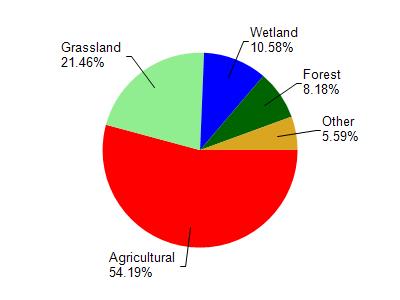Manitowoc
No
No
No
Fish and Aquatic Life
Overview
Kriwanek Creek is a small tributary to the West Twin River that has a moderate gradient (27.8 feet per mile), gravel and rubble substrate, and good flow in the lower reach due to numerous springs and small tributaries. The lower 0.6 mile of stream is classified as Class II brown trout water. However, the stream is not stocked due to lack of public access. This reach is only partially meeting its potential use due to streambank pasturing. The classification above this reach is as a forage fishery for nearly one mile, and then as limited aquatic life. Fisheries staff noted that the Maribel Sewage Treatment Plant discharges to a tributary of Kriwanek Creek and that chloride concentrations could be limiting ecological health.
Date 2001
Author Michael Toneys
Historical Description
Stream habitat evaluators ranked habitat in Kriwanek Creek, as good but some erosion and soft deposition areas were noted (Bougie and Cleereman 1996). Invertebrate analysis (HBI scores) indicted that the stream had excellent water quality. Fish surveys in the 1950’s (Hacker 1956), 1960’s (Hacker 1967) and 1970’s (Schultz 1972) indicated that brown trout, sculpin, mud minnows, longnose dace, southern redbelly dace, stone rollers and white sucker reside in the creek. More recent fish surveys in 2002 and 2008 had similar results to what was noted in earlier surveys, with brown trout, sculpin and dace dominating the catch.
Date 2011
Author Mary Gansberg
Condition
Wisconsin has over 84,000 miles of streams, 15,000 lakes and milllions of acres of wetlands. Assessing the condition of this vast amount of water is challenging. The state's water monitoring program uses a media-based, cross-program approach to analyze water condition. An updated monitoring strategy (2015-2020) is now available. Compliance with Clean Water Act fishable, swimmable standards are located in the Executive Summary of Water Condition in 2018. See also the 'monitoring and projects' tab.
Reports
Recommendations
Monitor for Use Designation
Assess condition of Kriwanek Creek to confirm natural community and water condition status. Confirm aquatic life use designation (LFF Survey from 1975).
Management Goals
Wisconsin's Water Quality Standards provide qualitative and quantitative goals for waters that are protective of Fishable, Swimmable conditions [Learn more]. Waters that do not meet water quality standards are considered impaired and restoration actions are planned and carried out until the water is once again fishable and swimmable
Management goals can include creation or implementation of a Total Maximum Daily Load analysis, a Nine Key Element Plan, or other restoration work, education and outreach and more. If specific recommendations exist for this water, they will be displayed below online.
Monitoring
Monitoring the condition of a river, stream, or lake includes gathering physical, chemical, biological, and habitat data. Comprehensive studies often gather all these parameters in great detail, while lighter assessment events will involve sampling physical, chemical and biological data such as macroinvertebrates. Aquatic macroinvertebrates and fish communities integrate watershed or catchment condition, providing great insight into overall ecosystem health. Chemical and habitat parameters tell researchers more about human induced problems including contaminated runoff, point source dischargers, or habitat issues that foster or limit the potential of aquatic communities to thrive in a given area. Wisconsin's Water Monitoring Strategy was recenty updated.
Grants and Management Projects
Monitoring Projects
| WBIC | Official Waterbody Name | Station ID | Station Name | Earliest Fieldwork Date | Latest Fieldwork Date | View Station | View Data |
|---|
| 88000 | Kriwanek Creek | 363264 | Kriwanek Creek - Hidden Valley Rd | 3/30/1994 | 11/3/1994 | Map | Data |
| 88000 | Kriwanek Creek | 10009818 | Kriwanek Creek - Kriwanik Creek at Hidden Valley Rd | 10/17/2002 | 10/25/2023 | Map | Data |
|

Watershed Characteristics
Kriwanek Creek is located in the West Twin River watershed which is 180.11 mi². Land use in the watershed is primarily agricultural (54.30%), grassland (21.50%) and a mix of wetland (10.60%) and other uses (13.80%). This watershed has 360.91 stream miles, 1,898.59 lake acres and 10,189.53 wetland acres.
Nonpoint Source Characteristics
This watershed is ranked High for runoff impacts on streams, Medium for runoff impacts on lakes and High for runoff impacts on groundwater and therefore has an overall rank of High. This value can be used in ranking the watershed or individual waterbodies for grant funding under state and county programs.However, all waters are affected by diffuse pollutant sources regardless of initial water quality. Applications for specific runoff projects under state or county grant programs may be pursued. For more information, go to surface water program grants.